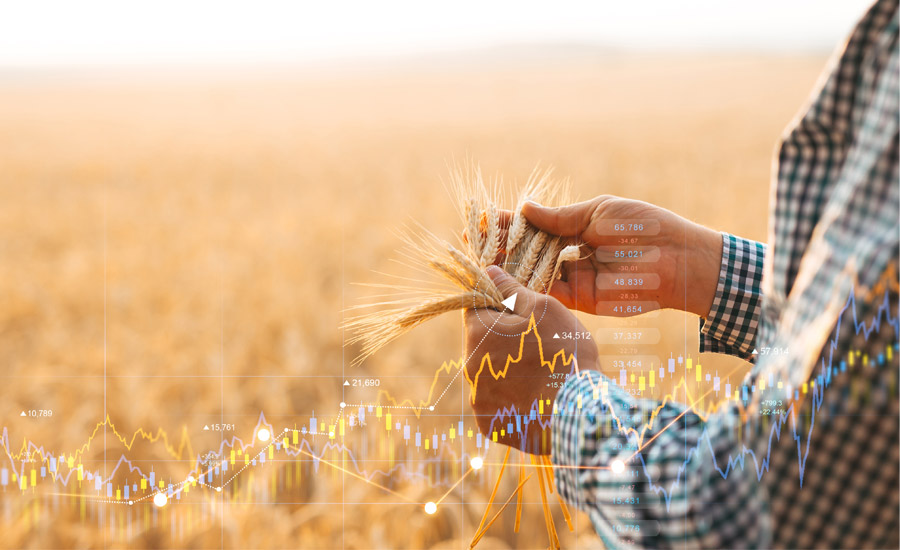By Cam Suárez-Bitár
A few years ago, archaeologists found the remnants of a fossilized bread in Jordan dating back nearly 14,000 years (see “14,000-Year-Old Piece Of Bread Rewrites The History Of Baking And Farming,” NPR, July 24, 2018). And there isn’t a dough conditioner or softener on Earth that could bring it back to life.
Nevertheless, since that ancient artisan’s turn at the fireplace, humankind has walked all seven continents and seen the rise and fall of countless civilizations, leaving breadcrumbs along the way to trace thousands of years of human history.
Baking always involves challenges—which can be rewarding and, at times, frustrating—but today, the production of humankind’s oldest processed food faces a challenge of historic proportions. From industrial bakeries to local artisan shops, bakers are increasingly concerned as a major global wheat supply crisis unfolds with no clear end in sight.
Supply-chain challenges
“It’s really hard to say how long it’s going to last. With Ukraine and Russia being top global wheat producers, and the inability to get grains out of Ukraine through the Black Sea, it’s going to take a long time for the market to equilibrate,” says Walt Postelwait, president of Pak Group/Bellarise. When asked if wheat price volatility would lead growers of other crops in the U.S, China, and other markets to switch to wheat, Postelwait said, “Very possibly, but that takes seasons. It’s not a short-term fix.” (For more perspective on the current global grain supply-chain dynamics, see “Market perspectives on global grain sourcing” on SnackandBakery.com.)
As the price and availability of wheat goes, so do the cost and supply of vital wheat gluten. Exactly how a bakery overcomes price instability as seen in the current wheat market requires careful consideration. A key baking ingredient derived from wheat and possessing unique dough conditioning qualities, vital wheat gluten improves a dough’s strength and elasticity, helps it absorb water, improves dough rheology, and enhances its crumb and volume. Because of these essential dough conditioning attributes, vital wheat gluten’s role is truly “vital,” making it imperative that bakeries adapt their recipes in light of the highly volatile wheat market.
It really is vital
To mitigate these substantial fluctuating supply and costs, “Bakers simply cannot remove vital wheat gluten from their whole wheat breads, organic breads, multigrain breads, or breads that have inclusions like fruits, grains, or seeds,” states Michael Heimink, technical applications manager at Bellarise®. Instead, industrial bakeries and artisan bakers must challenge ingredient suppliers to craft solutions that reduce their reliance on vital wheat gluten while yielding results that are as good as, or better than, their standard.
So, what exactly is vital wheat gluten? Also known as “wheat gluten or “wheat protein,” vital wheat gluten is made from wheat flour and is mostly comprised of about 75% wheat protein, on average, though it can vary, according to Heimink. The wheat berry itself consists of three main parts: the bran, germ, and endosperm. The endosperm is used to make white flour (i.e., bread, high-gluten, etc.). With whole wheat and whole grain flour, all three parts—or the “whole” berry and its contents—are utilized. The bran and germ do not contribute to the elastic properties that the endosperm provides within a dough’s gluten matrix. Rather, they dilute its overall elasticity, and may compromise volume or oven spring.
So, bakers typically add vital wheat gluten to products such as whole wheat, wholegrain, and multigrain breads to increase the overall water absorption level, but mostly to increase the strength while also providing greater (better) volume in the finished product. Vital wheat gluten is used in rye breads as well, adds Heimink.
Since wheat gluten—or vital wheat gluten—strengthens a bread’s crumb, it helps keep breads in one piece. Whole wheat hoagies, for example, without the proper elasticity and crumb strength, could become unhinged (quite literally!) Bakeries may opt to add a very small percentage of vital wheat gluten to reinforce their hoagies and ensure that delis and sandwich lovers can enjoy a proper sub. For instance, when a whole wheat hoagie is elastic enough, it allows the person building a sub sandwich to cut it lengthwise and flip the top over without it breaking off. The hinge is its weakest point, but with a strong and elastic crumb, the hoagie can withstand a complete array of ingredients and sauces, leading to a thoroughly enjoyable sub.
Organic breads also depend on added organic vital wheat gluten for improved dough rheology, crumb strengthening and elasticity. “Higher levels or doses of organic vital wheat gluten are often used when baking with organic wheat flour,” according to Heimink. “On average—and depending on the recipe—organic white breads might call for adding 5-8% organic vital wheat gluten to get the elasticity and volume benefits the baker wants, while organic whole wheat breads and organic multigrain breads with inclusions might call for adding up to 20% or more organic vital wheat gluten,” the latter being a percentage that far exceeds the amounts of vital wheat gluten added to conventional breads.
Bakeries that produce organic breads are especially exposed to wheat price fluctuations, since the more organic vital wheat gluten they use, the more their costs will vary because of today’s highly volatile wheat market. If bakeries could control their costs, the more likely they could keep bread prices stable. That would help keep consumers in the center aisle, the perimeter, and the local bakery much happier through the difficult economy.
In addition to price considerations, when using vital wheat gluten, commercial and artisan bakeries must account for its overall quality, which depends on several variables. For example, environmental factors— such as an excessively dry or hot growing season— and the vital wheat gluten’s origin also determine protein content in the vital wheat gluten used. Too much variance in protein levels may lead to inconsistent results in the oven. Of course, pre-fermenting is an option when optimizing a dough’s water absorbency since it involves allowing it to soak for hours before baking. For industrial bakeries and bakers operating on tight schedules, though, waiting a long time for a dough with a lower wheat gluten content to absorb all the water it needs might not be feasible.
Today, bakeries must consider their options when improving water absorption, crumb strength, elasticity, volume, and overall dough rheology. Reducing dependence on vital wheat gluten would help bakeries consistently craft great breads, simplify production and purchasing, and promise a greater value to their customers. Achieving these goals, though, does not require that bakers depend exclusively on vital wheat gluten, thanks to work being done by ingredient suppliers with expertise in modern enzyme technology.
The replacements
Industrial bakeries and artisan bakeries alike could gain control over variables such as cost, quality, and production time when vital wheat gluten is either in low supply, too expensive, or both. “Enzyme-based gluten replacers help doughs absorb water and develop stronger gluten bonds while lowering vital wheat gluten usage rates. Depending on the application, they can be formulated to be clean label, non-GMO, and organic,” according to Postelwait. “They interact with the gluten and starch molecules in wheat flour to create a stronger gluten bond while maintaining the dough’s extensibility, allowing bakers to achieve the volume they need. With denser breads like bagels, vital wheat gluten usage rates can still be lowered by customized enzyme solutions, it just takes some testing to make sure that texture goals are met and that its characteristic ‘chew’ is maintained.” Every bread is different, so a nuanced approach is often recommended.
When lowering the amount of vital wheat gluten used in specific applications, the quality-to-savings ratio is part of what needs to get dialed in. For instance, organic breads see the greatest savings when reducing organic vital wheat gluten with custom enzyme-based gluten replacers. “Bakeries can cut their organic vital wheat gluten costs by anywhere from 15-30%, depending on the application and process,” says Postelwait. “We have also seen applications where you can remove 10-25% of wheat gluten.” At that point, the supplier and bakery work together as a team to ensure that quality and customer expectations are met.
Suppliers can take extra steps to help simplify vital wheat gluten reduction. One of the key benefits of working closely with a knowledgeable ingredient supplier is ensuring that the label on the finished product’s package remains the same. “Enzyme-based gluten replacers typically don’t affect labeling in the U.S. market because it’s considered an incidental ingredient,” adds Postelwait. That keeps labels short for consumers and unchanged for suppliers, thereby managing expectations and avoiding the costs associated with package redesigns, respectively. Implementing a supplier’s expertise in enzyme technology also makes it easier for industrial bakeries to reduce vital wheat gluten usage rates and train their employees.
Complementing each other
Approximately 14,000 years have passed since the baker mentioned earlier baked their bread over a fire in the Jordanian desert, and today we see a crowded planet with bakers on every continent using modern technology to bake better breads. Today, bakers may buy wheat flour from North America, Europe, Asia, and elsewhere, with a myriad of ingredients at their disposal. Artisan bakers and home bakers are joined by commercial bakeries in the pursuit of delicious and authentic recipes for an industrialized world, and there are about as many different baking processes as there are bakers.
Highly volatile wheat prices are swinging the pendulum of the cost of vital wheat gluten in both directions, challenging bakeries’ ability to plan their ingredient budgets, promise consumers the best value, and control processes and bread quality. As a result, breads requiring added vital wheat gluten are more difficult to produce, such as breads baked with inclusions, wholegrain breads, multigrain breads, rye breads, and organic breads.
Custom enzyme-based gluten replacers give bakeries a much-needed break when they are crafted by suppliers who partner with industrial and commercial bakeries, as well as artisan and retail bakeries. With the supplier’s experts being readily available, bakeries could run shifts through 24 hours and know that if there is a question, an answer is close by. Furthermore, when suppliers take the time to fully understand their bakery partners’ goals and processes, they can prepare finely tuned enzyme-based gluten replacers that are easy to use in specific production environments. In the end, enzyme-based gluten replacers simplify complex baking processes that are susceptible to volatile wheat supply and prices. Due to their formulation, enzyme-based gluten replacers also seldom require changes to product labels or packaging, since usage rates are often below levels requiring their listing on ingredient panels.
The goal is not to simply remove vital wheat gluten or replace it entirely, since it is, after all, a “vital” ingredient in many breads. Rather, enzyme-based gluten replacers reduce bakeries’ dependence on vital wheat gluten and reduce costs, cut usage rates, maximize bread quality, and even help lower the amount of vital wheat gluten in breads that are often overdosed with it, such as organic breads. By not overdosing breads with vital wheat gluten, bakeries may prevent several problems, including “keyhole” (which is when a pan bread’s sides buckle), a sticky crumb, and an overly earthy aroma that may hide pleasant notes released by other ingredients. Once the wheat market equilibrates, organic breads and others with a lower gluten content would benefit from enzyme-based gluten replacers, since they address important variables related to overall quality.
The art and science of baking complement each other; while one inspires, the other facilitates. With all of the resources and options that bakers have at their disposal, they can mitigate abstract challenges related to economics and focus on the matter at hand: the breads that have united humankind for thousands of years and recipes that will fascinate for many more to come.
Cam Suárez-Bitár, MSA, is director of marketing and public relations at Pak Group NA.




